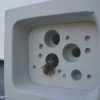Bee Brick & Bee Block
£21.00 – £32.00
The beautiful, polished cast concrete bee brick & bee block are designed to provide a nesting site for solitary bees, such as red mason bees and leaf cutter bees.
Of the 267 bee species in the UK, only a few of these are bumblebees and honey bees; these are the ones that live in hives, either wild or domesticated. The remaining 90% of bee species are solitary bees, and as they don’t have a hive and a queen to protect;
- they don’t sting unless you really treat them bad and then the sting is mild,
- they do a lot of good pollination work (they’re polylectic – they collect pollen from a wide range of plants) and they are responsible for around one third of the food we consume,
- sadly, their numbers are in decline.
Of these solitary bees some live underground (they can burrow under lawns) and some live in holes in wood and masonry.
And as well as being beautiful objects, what makes these bee bricks and blocks so fantastic is that the material they’re made of helps stabilise the temperature. Compared to the wooden bee nests, the bee brick and block cool slowly in winter and warm slowly in the sun, preventing large fluctuations in temperature; and it keeps the bees dry too; one of the problems with wooden cane nests is damp. The lovely people who make these have worked with the entomological department of the University of Exeter in Penryn, Falmouth to make sure they provide the bees with the ideal nest site. Things like hole size matter; some products made in other countries are not suited to the size of bees we get in the UK.
Solitary bee lifecycle
The female bee lays individual eggs into each cell – females at the back, male at the front – in the summer, with up to twenty larvae per cell. Laying each larvae on a ball of pollen glued together with nectar as food for the emerging new bees, she separates each of the larvae with a wall of local material – chewed up leaves, soil or even sand and a final plug to block the cell. The larvae then hatch over the next four to twenty weeks, depending on the species, but they don’t emerge straight away; they’ll spend the autumn and winter in there as little bees, between nine and eleven months, again depending on species, before emerging in the spring.
Location
Build the brick into a garden or building wall (it’s the same dimensions as a standard house brick) or even standalone.
As solitary bees are cold-blooded, they rely on the heat of the sun to warm them in the morning. Because of this please position the bee brick in a warm, sunny spot, south facing, with no vegetation in front of the holes. Ideally placed at least one metre from the ground.
If you need to clean out your bee brick, wait until mid March and then watch closely for bee activity, and then once you’re sure the cavity is empty, you can clean it with a pipecleaner.
Dimensions
The brick measures 215 mm × 105 mm × 65 mm.
The block measures 70 mm × 105 mm × 65 mm.
Bee brick & block material
Made in the UK (in sunny Cornwall) from china clay waste.
More information on solitary bees
You may also like…
-

Ceramic hanging bird bath
£48.00 Read more -

Belle bird feeder
£32.00 Select options This product has multiple variants. The options may be chosen on the product page -

Ceramic ball bird peanut feeder
£59.00 Select options This product has multiple variants. The options may be chosen on the product page











